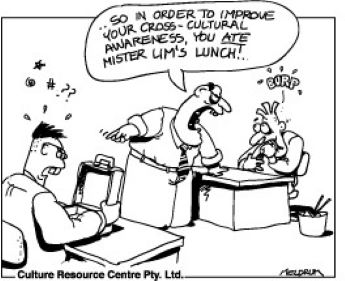Blog Culture@Work
Welcome! My name is Joost Thissen and here I like to share cultural columns and insights for those of us who are interested in culturally diverse and global workplaces.


Welcome! My name is Joost Thissen and here I like to share cultural columns and insights for those of us who are interested in culturally diverse and global workplaces.


We explored the concept of ‘battling with cultural awareness’ during staff focus group sessions for a client in the Finance industry. We asked participants what being ‘culturally aware’ meant to them, and how culturally aware they thought they were. Although most participants recognised that being cultural aware was important in a multicultural workplace, some of their explanations were quite revealing. Being culturally aware is a concept that might be easily misunderstood.
An interesting piece of footage comes from the movie “My fat Greek wedding”, where the main character, a Greek girl, ate lunch all by herself, because the other children could not stomach her Greek food. Being different for a child is usually not a good position to be in: they often feel the need to fit in with their peers to actually survive. I don’t think that by simply going to a school with children from culturally diverse backgrounds, this necessarily makes you culturally aware.
Culture can be defined as a learned system of values, beliefs, practices, customs, and behaviour that we share with others, which has been passed on from previous generations, and which gives us a sense of belonging and uniqueness.
Let us use Hall’s (1976) classic iceberg analogy of culture: only 10% of the total iceberg is visible above the surface of the water. It is the same with culture: we can only see roughly 10% of what makes up a person’s culture as only a small part of culture is open to view. This includes the conscious and visible aspects that are explicitly learned such as behaviour, e.g., greetings, language, communication style, humour, dress code, and what we eat.
The other 90% stays mostly below the waterline, its unconscious and invisible attributes are implicitly learned, such as perceptions, assumptions, beliefs, and values. They influence e.g., the way we view authority, apply thinking processes, and identify with others.
Although this 90% of a persons’ cultural frame can remain hidden forever from others (only shared with a select few), we do tend to make a lot of judgments and hold unconscious biases about other people’s culture by the way they behave and look.
During a training workshop, I recommended the movie ‘The Castle’ to a newly migrated Indian expat manager during a training. It was the esteemed ‘battler’ concept that I wanted to introduce to him. In Australian colloquialism, ‘battlers’ are ordinary working-class people who persevere through their commitments despite adversity. However, for an in-depth understanding it needs to be further explained by the Australian egalitarian attitude to authority, where people value being down to earth, sincere, humorous, and informal, show humility whilst loathing pretentiousness.
Some Australians in the group started to grin about my recommendation, and one person mentioned that ‘the battler is such an obvious concept in Australia’!
Yeah, yeah, no (to introduce an uniquely Australian phrase, which is a way to say ‘yes you understand’ but ‘no you don’t agree’): ‘obvious’ for Australians who were raised here, and who have learned both the visible (conscious) and invisible (unconscious) attributes of culture. However, for more recent arrivals this is quite a novel concept, with its unconscious meaning firmly hidden below the waterline. Knowledge about the egalitarian attitude, the down to earth values etc. might actually help new arrivals to understand and deal with Australians in a more culturally sensitive and knowledgeable way.
Cultural awareness is being sensitive to the fact that people from culturally diverse backgrounds behave and act the way they do (tip of the iceberg). They can be regarded as the more superficial attributes of cultures. For example, in some cultures, greetings are shown with a bow instead of a handshake. In other cultures, direct eye contact is considered impolite, while in some places it’s a sign of honesty and trust. Calling a spade, a spade is encouraged in some cultures, while being more diplomatic is believed the better way of communicating in other cultures.
Cultural self-awareness is the ability for introspection, and recognising how one’s own culture influences our behaviour in the tip of the iceberg. An awareness of our own cultural identity is a particularly good start to also become culturally aware of others. This self-awareness enables us to identify the own and others’ cultural framework, while being mindful to avoid using biases, and become better skilled in multiple perspective taking.
Being culturally aware allows us to understand and respect different cultures, and as a result, people start supporting cultural differences and embrace new ways to get along. It helps people break down cultural barriers and integrate respectfully with people at work, in the community and the multicultural society.
For some people cultural awareness seems to come more naturally. Others blindly hurtle forward, unaware that their ignorance is offensive and excludes others. In business, being aware of and sensitive to other cultures can win life-long relationships and business contracts. Cultural awareness is one of those abstract, ‘soft’ skills that take time to cultivate.
It was Jack Welch, CEO of GM between 1981 and 2001 who said:
“Dealing with Culture is a soft skill.
I learned it the hard way”.
There are a number of ways to create cultural (self)awareness, such as interacting with others, researching the internet, reading books, watching movies, taking part in training courses, and taking self-assessments. Being aware of and sensitive to other cultures will help people feel more comfortable with differences, and this enhances the inclusiveness in organisations. According to Jitske Kramer, a Dutch corporate anthropologist, being inclusive means that we create a safe environment where we are open to each other, can hear everyone’s differing ideas and opinions to allow us to come to better decisions (2022).
Culture affect how people prefer to be managed (or manage themselves), to be involved in decision making, to build relationships, to convince people, to schedule our tasks, to deliver or accept feedback, and to deal with conflict. These work preferences are related to the hidden attributes underneath the waterline such as the way we view authority, apply thinking processes, identify with others, perceive time and use communication: invaluable information when we work with culturally diverse people in multicultural and international workplaces.
Learning to work effectively with people from culturally diverse backgrounds is an evolutionary process that continues throughout life, if you are open to it. Once a person is aware that culture impacts behaviour, they can start to look beyond the visible and superficial behaviour. They need to explore the more hidden attributes below the icebergs’ waterline, which guides how we prefer to work, communicate and collaborate with others.
We should distinguish a number of development phases: starting with creating cultural awareness, followed by building on cultural knowledge, then practicing intercultural skills, and finally developing intercultural competencies to effectively deal with culturally diverse people in our workplaces.
Beyond battling with cultural awareness, professionals need the cultural competence to overcome cultural barriers and integrate the cultural gaps.
____________________________
Joost Thissen, Partner & Interculturalist
joost@cultureresourcecentre.com.au
cultural column  Email This Post
Email This Post